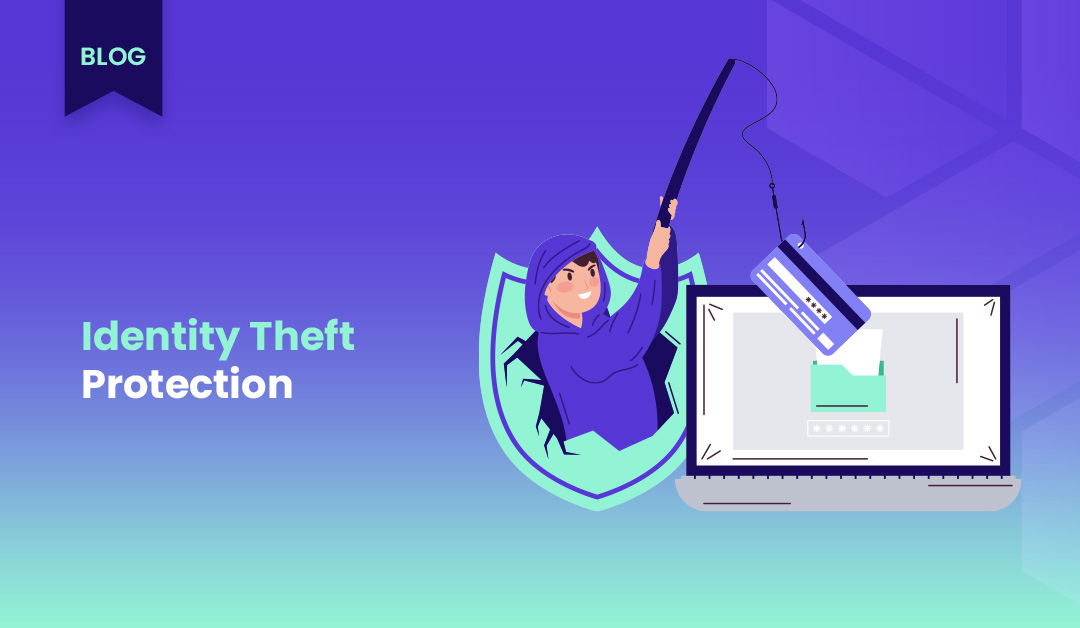Identity Theft Protection: How to Safeguard Your Personal Information
In today's interconnected digital landscape, protecting your personal information has become more crucial than ever. With cybercriminals constantly devising new methods to exploit vulnerabilities, understanding the intricacies of identity theft and implementing robust protection measures is essential for safeguarding your digital presence.
Author
Date
Category
All Categories
- AI-powered security
- Attacks & Threats
- Cybersecurity
- Hybrid Cloud
- Network
- Network Firewall
- Network Protection
- News
- Remote Workforce
- Security
- Zero Trust
Contents
Popular Posts
Product
Join the Newsletter

In today’s interconnected digital landscape, protecting your personal information has become more crucial than ever. With cybercriminals constantly devising new methods to exploit vulnerabilities, understanding the intricacies of identity theft and implementing robust protection measures is essential for safeguarding your digital presence. This comprehensive guide delves into the world of identity theft protection, offering valuable insights and practical strategies to help you secure your personal data and maintain peace of mind in an increasingly digital world.
What is Identity Theft?
Identity theft is a pervasive crime where unauthorized individuals obtain and use someone else’s personal information for fraudulent purposes. This includes sensitive data like Social Security numbers, credit card details, and bank account information. Perpetrators exploit this stolen information for various fraudulent activities, causing devastating consequences for the victims. The impact of identity theft goes beyond financial fraud, leading to damaged credit scores, unauthorized accounts, and legal troubles. In the digital age, identity theft has evolved with techniques like phishing scams, data breaches, and social engineering. The rise of social media and online sharing has increased the risk of identity theft. Understanding the nature of identity theft is crucial for developing effective protection strategies and minimizing the risk of falling victim to this threat.
Common Types of Identity Theft
Identity theft can occur in various forms, each targeting different aspects of an individual’s personal information. Understanding these common types of identity theft is crucial for developing comprehensive protection strategies. Here are some of the most prevalent forms of identity theft:
- Financial Identity Theft: This is perhaps the most well-known form of identity theft. It involves the unauthorized use of someone’s financial information, such as credit card numbers or bank account details, to make purchases, withdraw funds, or open new accounts. Financial identity theft can have severe consequences, including damaged credit scores and significant financial losses.
- Medical Identity Theft: In this type of fraud, criminals use stolen personal information to obtain medical services, prescription drugs, or file false insurance claims. Medical identity theft can lead to incorrect medical records, which may have life-threatening consequences if left uncorrected.
- Criminal Identity Theft: This occurs when an impersonator provides false identification to law enforcement, often during an arrest. The victim may find themselves with a criminal record or outstanding warrants in their name, potentially leading to legal troubles and damaged reputation.
- Synthetic Identity Theft: This sophisticated form of fraud involves creating a new identity by combining real and fabricated information. Criminals may use a real Social Security number with a fake name and address to create a new identity, making it challenging to detect and resolve.
- Tax Identity Theft: In this scenario, fraudsters use stolen personal information to file false tax returns and claim refunds. Victims may face difficulties when attempting to file their legitimate tax returns and may have to navigate complex processes to rectify the situation with tax authorities.
- Employment Identity Theft: Criminals use stolen identities to gain employment, often in situations where they may not be eligible to work legally. This can lead to tax implications and other legal issues for the victim.
- Social Media Identity Theft: With the prevalence of social media, criminals can create fake profiles using stolen personal information. These profiles may be used for various fraudulent activities, including scams or damaging the victim’s reputation.
Best Practices for Protecting Yourself from Identity Theft
Safeguarding your personal information against identity theft requires a proactive approach and the implementation of robust security measures. By adopting these best practices, you can significantly reduce your risk of falling victim to identity theft and better protect your digital presence:
- Secure Your Personal Documents:
- Keep important documents such as your Social Security card, birth certificate, and passport in a secure location, preferably a locked safe or safety deposit box.
- Strengthen Your Online Security:
- Use strong, unique passwords for all your online accounts. Consider using a reputable password manager to help generate and store complex passwords securely.
- Enable two-factor authentication (2FA) whenever possible to add an extra layer of security to your accounts.
- Monitor Your Financial Accounts:
- Regularly review your bank and credit card statements for any suspicious activity.
- Protect Your Digital Devices:
- Install and maintain reputable antivirus and anti-malware software on all your devices.
- Be Mindful of Phishing Attempts:
- Be skeptical of unsolicited emails, text messages, or phone calls asking for personal information.
What to Do if You Fall Victim to Identity Theft?
Discovering that you’ve become a victim of identity theft can be a distressing experience. However, taking swift and decisive action can help mitigate the damage and set you on the path to recovery. If you suspect or confirm that your identity has been stolen, follow these essential steps:
- Immediate Action:
- Contact your financial institutions: Inform your banks, credit card companies, and other financial service providers about the identity theft. Request to freeze or close compromised accounts and change all passwords and PINs.
- Place a fraud alert: Contact one of the three major credit bureaus (Equifax, Experian, or TransUnion) to place a fraud alert on your credit report. This alert notifies potential creditors to take extra steps to verify your identity before granting credit in your name.
- File an identity theft report: Submit a report with the Federal Trade Commission (FTC) at IdentityTheft.gov. This report is crucial for disputing fraudulent charges and accounts.
- Notify Relevant Authorities:
- If your Social Security number was compromised, contact the Social Security Administration.
- Report stolen checks to check verification companies.
- If your driver’s license was stolen, contact your state’s Department of Motor Vehicles.
- Address Specific Types of Fraud:
- For tax-related identity theft, contact the Internal Revenue Service (IRS) and your state tax agency.
- If medical identity theft is suspected, review your Explanation of Benefits statements and contact your health insurance provider.
- Update Your Security Measures:
- Change passwords and security questions for all your online accounts, especially those related to financial services.
- Enable two-factor authentication wherever possible.
- Review and strengthen your overall digital security practices.
Why Identity Theft Protection is Crucial?
In our digital world, identity theft protection is crucial. As technology becomes more integrated into our lives, the risk of identity theft grows. Understanding the importance of protection can motivate individuals to safeguard their personal information.
- Financial Security: Identity theft can have devastating financial consequences. Criminals can drain bank accounts, max out credit cards, or take out loans in your name, potentially leaving you with significant debt and a damaged credit score. Robust identity theft protection measures help safeguard your financial assets and maintain your financial stability.
- Preservation of Credit Score: Your credit score is a crucial factor in many aspects of your life, from obtaining loans to securing housing. Identity theft can severely impact your credit score, making it difficult to access credit when you need it. Protecting your identity helps maintain the integrity of your credit history and score.
- Personal Privacy: Identity theft protection goes hand in hand with maintaining your personal privacy. By safeguarding your personal information, you retain control over who has access to your data and how it’s used, preserving your right to privacy in an increasingly interconnected world.
- Prevention of Legal Issues: Identity thieves may commit crimes using your identity, potentially leading to legal troubles for you. Robust protection measures help prevent such scenarios, saving you from potential legal headaches and the associated costs.
- Rapid Detection and Response: Many identity theft protection services offer real-time monitoring and alerts. This means that if any suspicious activity occurs, you can be notified quickly, allowing for a rapid response that can minimize potential damage.
- Evolving Threat Landscape: As technology advances, so do the methods employed by identity thieves. Staying informed about the latest protection measures and implementing them is crucial in keeping pace with evolving threats.
Taking Action Against Identity Theft
Combating identity theft requires a proactive approach that combines vigilance, education, and robust security measures. By taking decisive action against identity theft, you protect yourself and contribute to the broader fight against this crime. Here are key steps to combat identity theft:
- Implement Strong Security Practices:
- Use complex, unique passwords for all your accounts and consider using a reputable password manager.
- Enable two-factor authentication wherever possible to add an extra layer of security.
- Regularly update your devices’ operating systems and applications to ensure you have the latest security patches.
- Educate Yourself and Stay Informed:
- Keep up-to-date with the latest identity theft trends and scams.
- Attend workshops or webinars on cybersecurity and identity protection.
- Follow reputable sources for information on emerging threats and protection strategies.
- Educate Others:
- Share your knowledge about identity theft protection with friends, family, and colleagues.
- Encourage others to implement strong security practices and stay vigilant against potential threats.
- Respond Quickly to Potential Threats:
- If you suspect your information has been compromised, act swiftly to mitigate potential damage.
- Place fraud alerts or credit freezes on your credit reports if you believe you’re at risk.
- Report any suspicious activity to the relevant authorities and financial institutions immediately.
FAQ
Protecting yourself from identity theft involves a multi-faceted approach:
1-Secure your personal information: Be cautious about sharing sensitive data and keep important documents in a safe place.
2-Use strong, unique passwords for all accounts and enable two-factor authentication where possible.
3-Regularly monitor your financial statements and credit reports for any suspicious activity.
4-Be wary of phishing attempts and unsolicited requests for personal information.
Multi-factor authentication (MFA) is a powerful tool in preventing identity theft:
1-Additional layer of security: MFA requires users to provide two or more pieces of evidence (factors) to verify their identity, making it much harder for unauthorized individuals to gain access to accounts.
2-Real-time alerts: Many MFA systems send notifications when someone attempts to access your account, allowing you to quickly identify and respond to potential threats.
3-Mitigation of password vulnerabilities: Even if a password is compromised, the additional authentication factor(s) can prevent unauthorized access.
4-Compliance with security standards: Many industries require MFA as part of their security compliance standards, ensuring a higher level of protection for sensitive information.
Recognizing the signs of identity theft early can help minimize potential damage. Here are key indicators to watch for:
1-Unexpected changes in your credit score or unfamiliar items on your credit report.
2-Unexplained withdrawals or charges on your bank or credit card statements.
3-Bills or collection notices for accounts you didn’t open.
4-Receiving notification that your information was compromised in a data breach.
5-Unexpected medical bills or Explanation of Benefits (EOB) statements for services you didn’t receive.
Get Started with Timus
Zero Trust. Adaptive Cloud Firewall. Secure Remote Access. In one.
